One of the major problems that is to be solved in an electronic circuit design is the production of low voltage DC power supply from AC to power the circuit. The conventional method is the use of a step-down transformer to reduce the 230 V AC to a desired level of low voltage AC. The most suitable and low cost method is the use of aVoltage Dropping Capacitor in series with the phase line.
Selection of the Dropping capacitor and the circuit design requires some technical knowledge and practical experience to get the desired voltage and current. An ordinary capacitor will not do the job since the device will be destroyed by the rushing current from the mains. Mains spikes will create holes in the dielectric and the capacitor will fail to work. X-rated Capacitor specified for the use in AC mains is required for reducing AC voltage.
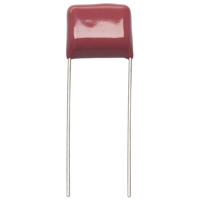
X Rated capacitor 400 Volt
Before selecting the dropping capacitor, it is necessary to understand the working principle and operation of the dropping capacitor. The X rated capacitor is designed for 250, 400, 600 VAC. Higher voltage versions are also available. The Effective Impedance ( Z ),Rectance ( X ) and the Mains frequency ( 50 – 60 Hz ) are the important parameters to be considered while selecting the capacitor. The reactance(X ) of the capacitor ( C )in the mains frequency ( f ) can be calculated using the formula
X = 1 / (2 ¶ fC )
For example the reactance of a 0.22 uF capacitor running in the mains frequency 50Hz will be X = 1 / {2 ¶ x 50 x 0.22 x( 1 / 1,000,000) } = 14475.976 Ohms 0r 14.4 Kilo ohms. Rectance of the capacitor 0.22 uF is calculated as X=1/2Pi.f.C.Where f is the 50 Hz frequency of mains and C is the value of capacitor in Farads. That is 1 microfarad is 1 / 1,000,000 farads.Hence 0.22 microfarad is 0.22 x 1 / 1,000,000 farads. Therefore the rectance of the capacitor appears as 14475.97 Ohms or 14.4 K Ohms.To get current I divide mains Volt by the rectance in kilo ohm.That is 230 / 14.4 = 15.9 mA.
Effective impedance (Z) of the capacitor is determined by taking the load resistance ( R ) as an important parameter. Impedance can be calculated using the formula
Z = v R + X
Suppose the current in the circuit is I and Mains voltage is V then the equation appears like
I = V / X
The final equation thus becomes
I = 230 V / 14. 4 = 15.9 mA.
Therefore if a 0.22 uF capacitor rated for 230 V is used, it can deliver around 15 mAcurrent to the circuit. But this is not sufficient for many circuits. Therefore it is recommended to use a 470 nF capacitor rated for 400 V for such circuits to give required current.
X Rated AC capacitors – 250V, 400V, 680V AC
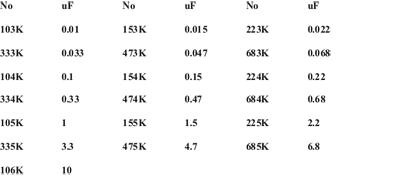
Table showing the X rated capacitor types and the output voltage and current without load

Rectification
Diodes used for rectification should have sufficient Peak inverse voltage (PIV). The peak inverse voltage is the maximum voltage a diode can withstand when it is reverse biased. 1N 4001 diode can withstand up to 50 Volts and 1N 4007 has a toleration of 1000 Volts. The important characteristics of general purpose rectifier diodes are given in the table.
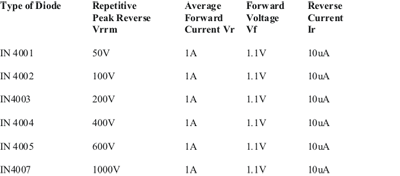
So a suitable option is a rectifier diode 1N4007. Usually a silicon diode has a Forward voltage drop of 0.6 V. The current rating (Forward current) of rectifier diodes also vary. Most of the general purpose rectifier diodes in the 1N series have 1 ampere current rating.
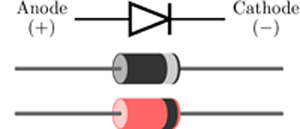
DC Smoothing
A Smoothing Capacitor is used to generate ripple free DC. Smoothing capacitor is also called Filter capacitor and its function is to convert half wave / full wave output of the rectifier into smooth DC. The power rating and the capacitance are two important aspects to be considered while selecting the smoothing capacitor. The power rating must be greater than the off load output voltage of the power supply. The capacitance value determines the amount of ripples that appear in the DC output when the load takes current. For example, a full wave rectified DC output obtained from 50Hz AC mains operating a circuit that is drawing 100 mA current will have a ripple of 700 mV peak-to-peak in the filter capacitor rated 1000 uF. The ripple that appears in the capacitor is directly proportional to the load current and is inversely proportional to the capacitance value. It is better to keep the ripple below 1.5 V peak-to-peaks under full load condition. So a high value capacitor (1000 uF or 2200 uF) rated 25 volts or more must be used to get a ripple free DC output. If ripple is excess it will affect the functioning of the circuit especially RF and IR circuits.
Voltage Regulation
Zener diode is used to generate a regulated DC output. A Zener diode is designed to operate in the reverse breakdown region. If a silicon diode is reverse biased, a point reached where its reverse current suddenly increases. The voltage at which this occurs is known as“Avalanche or Zener “value of the diode. Zener diodes are specially made to exploit the avalanche effect for use in ‘Reference voltage ‘regulators. A Zener diode can be used to generate a fixed voltage by passing a limited current through it using the series resistor (R). The Zener output voltage is not seriously affected by R and the output remains as a stable reference voltage. But the limiting resistor R is important, without which the Zener diode will be destroyed. Even if the supply voltage varies, R will take up any excess voltage. The value of R can be calculated using the formula
R = Vin – Vz / Iz
Where Vin is the input voltage, Vz output voltage and Iz current through the Zener
In most circuits, Iz is kept as low as 5mA. If the supply voltage is 18V, the voltage that is to be dropped across R to get 12V output is 6volts. If the maximum Zener current allowed is 100 mA, then R will pass the maximum desired output current plus 5 mA . So the value of R appears as
R = 18 – 12 / 105 mA = 6 / 105 x 1000 = 57 ohms
Power rating of the Zener is also an important factor to be considered while selecting the Zener diode. According to the formula P = IV. P is the power in watts, I current in Amps and V, the voltage. So the maximum power dissipation that can be allowed in a Zener is the Zener voltage multiplied by the current flowing through it. For example, if a 12V Zener passes 12 V DC and 100 mA current, its power dissipation will be 1.2 Watts. So a Zener diode rated 1.3W should be used.
LED Indicator and Diagram
LED Indicator
LED indicator is used as power on indicator. A significant voltage drop (about 2 volts) occurs across the LED when it passes forward current. The forward voltage drops of various LEDs are shown in Table.

A typical LED can pass 30 –40 mA current without destroying the device. Normal current that gives sufficient brightness to a standard Red LED is 20 mA. But this may be 40 mA for Blue and White LEDs. A current limiting resistor is necessary to protect LED from excess current that is flowing through it. The value of this series resistor should be carefully selected to prevent damage to LED and also to get sufficient brightness at 20 mA current. The current limiting resistor can be selected using the formula
R = V / I
Where R is the value of resistor in ohms, V is the supply voltage and I is the allowable current in Amps. For a typical Red LED, the voltage drop is 1.8 volts. So if the supply voltage is 12 V (Vs), voltage drop across the LED is 1.8 V (Vf) and the allowable current is 20 mA (If) then the value of the series resistor will be
Vs – Vf / If = 12 – 1.8 / 20 mA = 10.2 / 0.02 A = 510 Ohms.
A suitable available value of resistor is 470 Ohms. But is advisable to use 1 K resistor to increase the life of the LED even though there will be a slight reduction in the brightness. Since the LED takes 1.8 volts, the output voltage will be 2 volts less than the value of Zener. So if the circuit requires 12 volts, it is necessary to increase the value of Zener to 15 volts. Table given below is a ready reckoner for selecting limiting resistor for various versions of LEDs at different voltages.
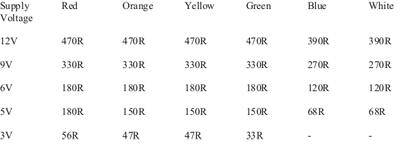
Circuit Diagram
The diagram shown below is a simple transformer less power supply. Here 225 K(2.2uF) 400 volts X rated capacitor is used to drop 230 volt AC. Resistor R2 is the bleeder resistor that remove the stored current from the capacitor when the circuit is unplugged. Without R2, there is chance for fatal shock if the circuit is touched. Resistor R1 protects the circuit from inrush current at power on. A full wave rectifier comprising D1 through D4 is used to rectify the low voltage AC from the capacitor C1 and C2 removes ripples from the DC. With this design, around 24 volts at 100 mA current will be available in the output.This 24 volt DC can be regulated to required output voltage using a suitable 1 watt Zener. It is better to add a safety fuse in the phase line and an MOV across the phase and neutral lines as safety measure if there is voltage spike or short circuit in the mains.
Caution: Construction of this form of power supply is recommended only to those persons experienced or competent in handling AC mains. So do not try this circuit if you are not experienced in handling High voltages.
The drawback of the Capacitor power supply includes
1. No galvanic isolation from Mains.So if the power supply section fails, it can harm the gadget.
2. Low current output. With a Capacitor power supply. Maximum output current available will be 100 mA or less.So it is not ideal to run heavy current inductive loads.
3. Output voltage and current will not be stable if the AC input varies.
Caution
Great care must be taken while testing the power supply using a dropping resistor. Do not touch at any points in the PCB since some points are at mains potential. Even after switching off the circuit, avoid touching the points around the dropping capacitor to preventelectric shock. Extreme care should be taken to construct the circuit to avoid short circuits and fire. Sufficient spacing must be given between the components. The high value smoothing capacitor will explode, if is connected in the reverse polarity. The dropping capacitor is non- polarized so that it can be connected either way round. The power supply unit must be isolated from the remaining part of the circuit using insulators. The circuit should be housed in metal case without touching any part of the PCB in the metal case. The metal case should be properly earthed.
Circuit Diagrams
Filed Under: Electronic Projects



Questions related to this article?
👉Ask and discuss on EDAboard.com and Electro-Tech-Online.com forums.
Tell Us What You Think!!
You must be logged in to post a comment.